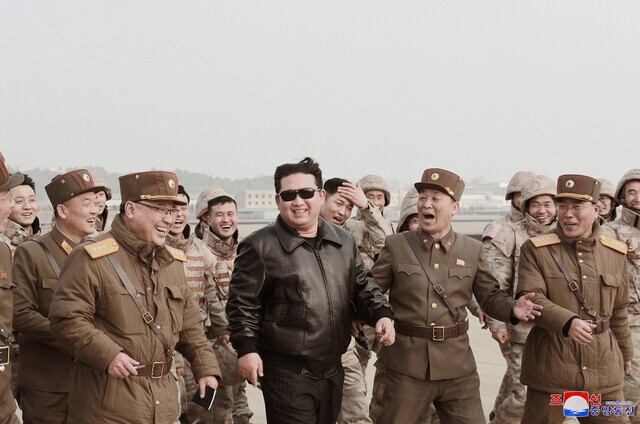hankyoreh
Links to other country sites 다른 나라 사이트 링크
N. Korea launched Hwasong-15, not Hwasong-17, S. Korean Defense Ministry says

According to South Korea’s Ministry of National Defense, the missile used in North Korea’s latest intercontinental ballistic missile (ICBM) launch was not the Hwasong-17 as it has claimed, but the existing Hwasong-15. The pretense is believed to be aimed at North Korea’s own population rather than the international community.
According to a report submitted by the Ministry of Defense to the National Assembly on Tuesday, an analysis of the flight characteristics of the missile launched on March 24 showed that it resembled the Hwasong-15 missile rather than the Hwasong-17.
The Hwasong-15 launched by North Korea in November 2017 had a peak altitude of 4,475 km, a flight distance of 950 km, and a flight time of 53 minutes. On the other hand, the ministry explained, last week’s missile had an estimated altitude of about 6,200 km or more and a flight distance of about 1,080 km, and a total range of more than 13,000 km when launched at a normal angle. According to North Korea, the flight time was 67 minutes.
However, after analyzing characteristics such as ascending acceleration, combustion time, and stage separation time, the ministry concluded that this missile was most likely the Hwasong-15.
In terms of technology, the Hwasong-17 missile has four sets of Paektusan series engines, but the ministry explained that the ICBM tested last week had only two engines, like the Hwasong-14 and Hwasong-15.
The report also said footage of the launch released by North Korea appeared to have been mixed with previously shot footage.
If the launch time was indeed 2:33 pm, like the North claimed, then Kim Jong-un’s shadow should be facing northeast, the ministry said, but it was not. Instead, the shadow can be seen facing west, leading analysts to believe the footage was recorded between 8 am and 10 am.
As to why North Korea chose to disguise the launch as the Hwasong-17, the ministry believes it has more to do with domestic factors than external considerations.
“With Pyongyang residents witnessing the failure of the [Hwasong-17] launch on March 16, [North Korea] needed to deliver a message of ‘success’ quickly to prevent rumors and stabilize the regime,” the ministry said. “Thus, it launched the Hwasong-15 instead.”
“Even if it means using deception, [North Korea’s] goal is to secure the status of a military power and enhance [its] negotiating power by convincing South Korea and the US that it has advanced its ICBM capabilities,” the ministry added.
By Hwang Joon-bum, staff reporter
Please direct questions or comments to [english@hani.co.kr]

Editorial・opinion
![[Column] Tariffs on China: Trump was dumb, Biden dumber [Column] Tariffs on China: Trump was dumb, Biden dumber](https://flexible.img.hani.co.kr/flexible/normal/500/300/imgdb/original/2024/0520/191716191153918.jpg) [Column] Tariffs on China: Trump was dumb, Biden dumber
[Column] Tariffs on China: Trump was dumb, Biden dumber![[Column] What if Seoul took reunification by force off the table? [Column] What if Seoul took reunification by force off the table?](https://flexible.img.hani.co.kr/flexible/normal/500/300/imgdb/original/2024/0520/3017161928630494.jpg) [Column] What if Seoul took reunification by force off the table?
[Column] What if Seoul took reunification by force off the table?- [Editorial] Intensifying US-China rivalry means Seoul must address uncertainty with Beijing sooner than later
- [Column] When ‘fairness’ means hate and violence
- [Editorial] Yoon must stop abusing authority to shield himself from investigation
- [Column] US troop withdrawal from Korea could be the Acheson Line all over
- [Column] How to win back readers who’ve turned to YouTube for news
- [Column] Welcome to the president’s pity party
- [Editorial] Korea must respond firmly to Japan’s attempt to usurp Line
- [Editorial] Transfers of prosecutors investigating Korea’s first lady send chilling message
Most viewed articles
- 1Xi, Putin ‘oppose acts of military intimidation’ against N. Korea by US in joint statement
- 2Kim Jong-un wanted to meet with residents of shelled Yeonpyeong Island in South, Moon recalls in mem
- 3To weigh costs and benefits, Korea must stop treating US troop presence as a sacred cow
- 4[Column] What if Seoul took reunification by force off the table?
- 5Berlin mayor hints at tearing down ‘comfort women’ memorial in city
- 6[Column] Tariffs on China: Trump was dumb, Biden dumber
- 7[Exclusive] Truth commission to seek additional murder charges for figures behind 1980 Gwangju massa
- 8For new generation of Chinese artists, discontent is disobedience
- 9Naver’s union calls for action from government over possible Japanese buyout of Line
- 10[Editorial] Transfers of prosecutors investigating Korea’s first lady send chilling message